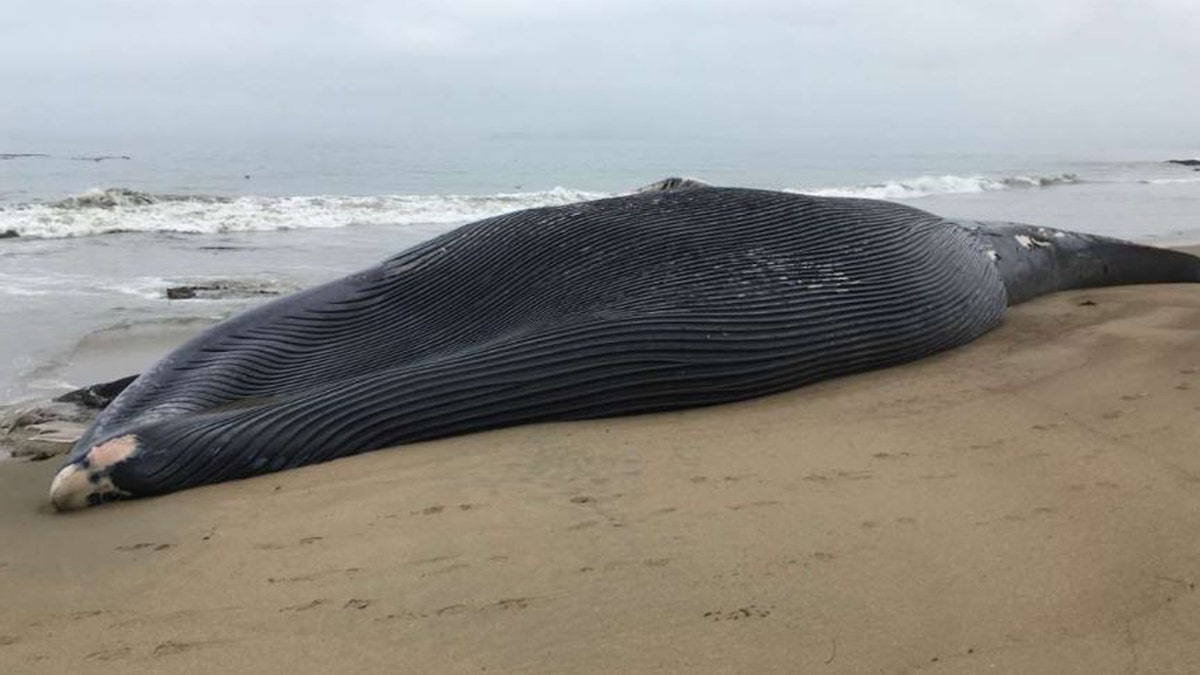
A 62-foot blue whale was found Monday ashore a beach north of San Francisco. Scientists said the animal died from a ship strike. (Marine Mammal Center via UC Santa Cruz)
A 62-foot blue whale carcass that washed ashore north of San Francisco on Monday died from a ship strike, the Marine Mammal Center said Tuesday.
The juvenile female blue whale died of “blunt force trauma consistent with vessel collision,” the nonprofit organization said in a statement.
“Blue whales are the largest animal on Earth and an endangered species, so to learn that this individual’s death is a result of a ship strike is particularly unfortunate,” said Barbie Halaska, a Marine Mammal Center researcher, told the Bay Area's KTVU2 FOX.
Human-caused ship strikes and fishing gear entanglements are “primary threats” to blue whales -- an endangered species -- and the leading cause of non-natural whale mortality, according to the center.
“Blue whales are the largest animal on Earth and an endangered species, so to learn that this individual’s death is a result of a ship strike is particularly unfortunate.”
A team of 19 scientists performed a necropsy on the blue whale and discovered multiple broken vertebrae and severe tissue hemorrhaging along the whale’s back, the Marin Independent Journal reported.
Upon closer inspection, scientists also found a severed spine and bruising to the ribs and lower jaw, the report said.
This is the 10th blue whale that the center has responded to in its 43-year history, according to the mammal center.
It was also the eighth whale of all kinds for the center this year, the Journal reported.
The blue whale was found decaying with its stomach “extremely bloated” as seagulls foraged through its remains, the San Francisco Chronicle reported.
Its carcass was discovered at the south of Limantour Beach in Point Reyes National Seashore, around 50 miles northwest of San Francisco.
Scientists from the Marine Mammal Center, California Academy of Sciences, Point Reyes National Seashore and the National Oceanic and Atmospheric Administration participated in the necropsy.
“Understanding and documenting the extent of the injuries through a necropsy allows us to share this information with decision-makers to help find solutions to prevent these incidents in the future,” Halaska said.
Blue whales, the largest animals on earth, usually grow between 80 and 100 feet long and are often found in groups, LiveScience reported.
But this whale was isolated, which could explain the ship strike.
On Saturday, a whale watching group near the Farallon Islands, about 27 miles off San Francisco, saw a dead and decaying blue whale floating on the water, the Chronicle reported.
"It could have drifted for miles, so it's a matter of re-sighting it," Bill Keener with Golden Gate Cetacean Research, told the paper.
About 2,800 blue whales, an endangered species, live off the coast of California, according to the mammal center.
Earlier this month, a blue whale turned up in the Red Sea, LiveScience reported.
In February, a 66-foot-long blue whale carcass was found along the coast of Chile desecrated with graffiti and stomped on by tourists, Fox News had reported.
